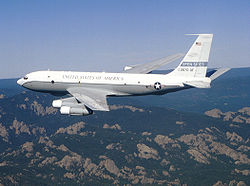Treaty on Open Skies
The Treaty on Open Skies began on January 1, 2002, and currently has 34 party states. It created a program of unarmed aerial surveillance flights over the entire territory of its participants.
The treaty is designed to help create a mutual understanding and confidence by giving all participants the ability to gather information about military forces and activities of concern to them.
The idea of "mutual aerial observation" was proposed to Soviet Premier Nikolai Bulganin at the Geneva Conference of 1955 by U.S. President Dwight D. Eisenhower. The treaty was eventually signed as an initiative of U.S. president George H. W. Bush in 1989. The agreement was signed in Helsinki, Finland, on March 24, 1992.
The United States officially withdrew on 22 November 2020.[1]
Treaty On Open Skies Media
An-30 monitoring aircraft
Tupolev Tu-214ON of the Russian Air Force
References
- ↑ "United States formally withdraws from Open Skies treaty - US & Canada". Al Jazeera. 2020-11-22. Retrieved 2020-11-22.



